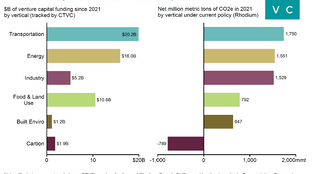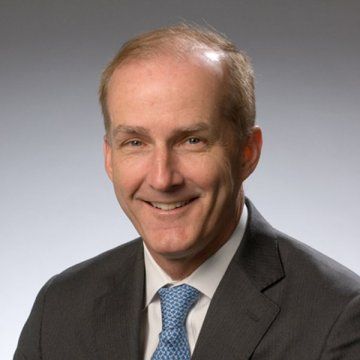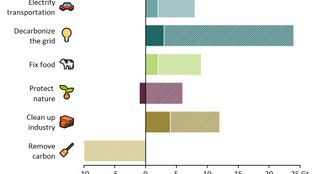
Rhodium: Taking stock of Paris targets
Late breaking ‘Inflation Reduction Act’ changes odds for the better w/ Rhodium’s Ben King
David Crane, best known as the former CEO of NRG Energy ousted in 2015 after years of trying to transition NRG into clean energy, has raised a high profile $230M Climate SPAC

David Crane, best known as the former CEO of NRG Energy ousted in 2015 after years of trying to transition NRG into clean energy, has raised a high profile $230M Climate SPAC along with a group of energy industry veterans including former Green Mountain Power CEO Mary Powell and ex-GE Vice Chair Beth Comstock. Climate Change Crisis Real Impact I is branded as the “world’s first climate-focused SPAC” and is targeting sectors such as renewables, grid stability, EV charging, circular economy, nature-based solutions and climate-friendly liquid fuels.
How did your past experiences lead you to starting one of the first climate-focused SPACs?
Most people know me from NRG. I tried to take a large power generation company that was concentrated on coal-fired power and turned it into a clean energy company fit for the 21st century – meaning not only green but also distributed and more customer facing. That obviously didn’t work. Starting five years ago, since my time there ended, I’ve been working with emerging growth companies in the clean energy space. I actually looked at raising a climate SPAC three years ago, but the timing wasn’t right. When I looked again in 2020, this new phase ushered in by Nikola changed several circumstances and made this an extremely auspicious time for a climate SPAC.
Why the sudden hype in SPACs this year? Why have SPACs been the go-to vehicle for private companies in the ESG space going public?
There are two reasons. The main reason now is that there has been this historical inversion between public markets and private equity when it comes to the value ascribed to long term growth potential. Previously, if you had a company with a big, risky, exciting growth story that required capital, it could only prove it out in private markets. Public markets, sometimes fairly and sometimes unfairly, were deemed to be focused on short term results to the exclusion of all else. Nikola has shown us the incredible level of interest from the public market for untapped clean sectors like hydrogen powered transportation, which was so early stage that it previously would have been limited to venture capital. It’s a change in a whole market segment’s risk profile.
The second reason stock markets are now compelling for green companies is just simple supply and demand. The amount of money flowing through sovereign wealth or pension funds trying to find a home in public market “ESG” investment right now is crazy high. There is a serious oversupply of money that wants to invest in sustainable names, relative to the lack of these companies available in the public market.
Last week we wrote about how the ESG SPAC space is becoming very crowded (almost 20 SPACs announced this year focusing on ESG). How will you differentiate and find a suitable ESG target?
There are “ESG” SPACs that have a very broad mandate since E, S and G cover almost everything and then there are so-called “energy transition” SPACs which seem to be populated by folks who were oil and gas people just a couple of weeks ago. We think the climate mission-driven companies we are targeting are going to feel most comfortable with a SPAC like ours, which is populated by sponsors and directors who have been authentic climate activists for some time. In my case, for example, you could argue that for many years I ran, in NRG, a large power generation company which was one of the biggest emitters in the United States. But you could also argue that I risked my millions-of-dollars-a-year job to go out on a limb and change that dirty, brown company into a clean, green company. Authentic operational and climate credentials are ultimately what these companies are looking for and also are what we are looking for in a combination partner.
Do you worry about all these pre-revenue companies holding up in the public markets for years?
I think a good number of these high risk, “moonshot” companies are going to fail but of the ones that succeed, there is a good possibility that one or more of them emerges as the “Google, Apple or Amazon” of clean energy with stratospheric returns for early shareholders. We’re early in the cycle so far so we haven’t seen any failures, but, when they occur, we will see whether the portfolio investors are still enthusiastic about the swing-for-the-fences attitude which is typically seen in VC. In the meantime, over the next 3-6 months, we think the irrational exuberance of earlier this year will abate and there will be a flight to quality, even amongst the moonshot companies. When we developed our climate SPAC a few months ago, we anticipated this evolution of the marketplace and brought in high quality sponsors and directors with PIMCO’s backing, who would signal to the market that we’re a “Blue Chip” SPAC in the climate space. No matter what, though, I think the SPAC form will certainly survive simply because, for the target companies, SPACs are so much a better option than late stage VC, private equity, a strategic sale or – particularly – a traditional IPO.
During that correction, someone loses money. Who do you think will lose out on SPACs?
It is easier to determine who will NOT lose – which is the rising target companies. If they can convince a sponsor to shoulder their innate risks by combining with them, they have little to lose. Even if they go for a SPAC combination and it doesn’t happen, they’re in the same place as they were before and, done right, it should not have cost them much time or money. For those in the sponsorship seat, like me and my co-sponsors, we have significant money at risk and can lose out if we don’t pick wisely. We also can lose all of our invested capital by not achieving a business combination within 24 months. If there are truly going to be 300 SPACs by the end of this year, some folks are going to have to downsize their SPAC, pick poor targets, or risk expiration of their SPAC with no transaction.
How will the reputational damage that Nikola has faced affect the rest of the ESG SPAC pipeline to come?
It’s an interesting situation. I’ve spent the last year being utterly fixated on hydrogen, and I was actually at Nikola the day that the SPAC showed up. Hydrogen fueled transportation is a future space that the market really likes, and despite what the Hindenburg report says, Nikola does have a truck that runs under its own power because I drove in it. Perhaps, in terms of the allegations, there should’ve been better due diligence done on the Nikola founder by the SPAC, but the most amazing thing to me is the resilience of the market value of Nikola even after its founder was forced to resign. It’s an indication of the market’s extraordinary excitement for the hydrogen mobility space. We’ll see what future investigations and revelations regarding Nikola hold, but the most amazing thing to me remains that the company still trades at such a high value.
What’s your approach to sourcing ESG targets?
We divide the climate space into nine or ten categories, more than half of which are on the clean energy side, but also includes the circular economy, direct air capture, responsible agriculture, and nature-based solutions. Our personal strong suit is in clean energy which we split into three categories: (1) winning the green home, (2) winning the green commercial building, and (3) winning green mobility. We focus on the end user because the energy world that we live in is driven by the consumer. It’s a period of almost unlimited energy supply, at least in North America, and so the customer gets to choose. Keep in mind that this CRIS SPAC is actually the first of three climate SPACs that we’re doing with PIMCO’s backing, so eventually we could look to expand our focus from clean energy into other climate areas.
What’s your diligence approach? What KPIs are you focused on?
The diligence isn’t that much different from a traditional M&A transaction. Since these companies are predominantly growth stories, the market has more emphasis on forward projections than on historical financial performance. Many of the companies we are looking at have substantial revenue and gross margin but don’t have free cash flow, so diligence is more around unit costs. Unit costs have become increasingly important because everyone these days is a little wary of what’s called the “Northern California Playbook,” where businesses are growing the revenue line by subsidizing sales – losing money on every new customer.
And what about quantifying the ‘impact’ of your target?
First of all, I’m not apologetic about this, but when it comes to ESG, my letters E, S, and G are different sizes. Good governance is a baseline, and it’s important that you always have the social component, but we’re most focused on the “E”. “E” stands for Climate for us! Within the climate space, I’m most excited in particular in companies with disruptive technologies that have a knock-on effect with the potential to revolutionize the space and reduce carbon emissions at a scale which is globally meaningful. Remember mankind these days is pumping roughly 40 billion tons of CO2 into the atmosphere every year and, over the next couple decades, it pretty much all has to stop. So when we talk about “climate real impact”, we are measuring in the billions!
Interested in more content like this? Subscribe to our weekly newsletter on Climate Tech below!

Late breaking ‘Inflation Reduction Act’ changes odds for the better w/ Rhodium’s Ben King

Out in front on carbon removal, Nan Ransohoff sets a new tier for climate leadership with Frontier

John Doerr and Ryan Panchadsaram's new book on OKRs to get to Net Zero